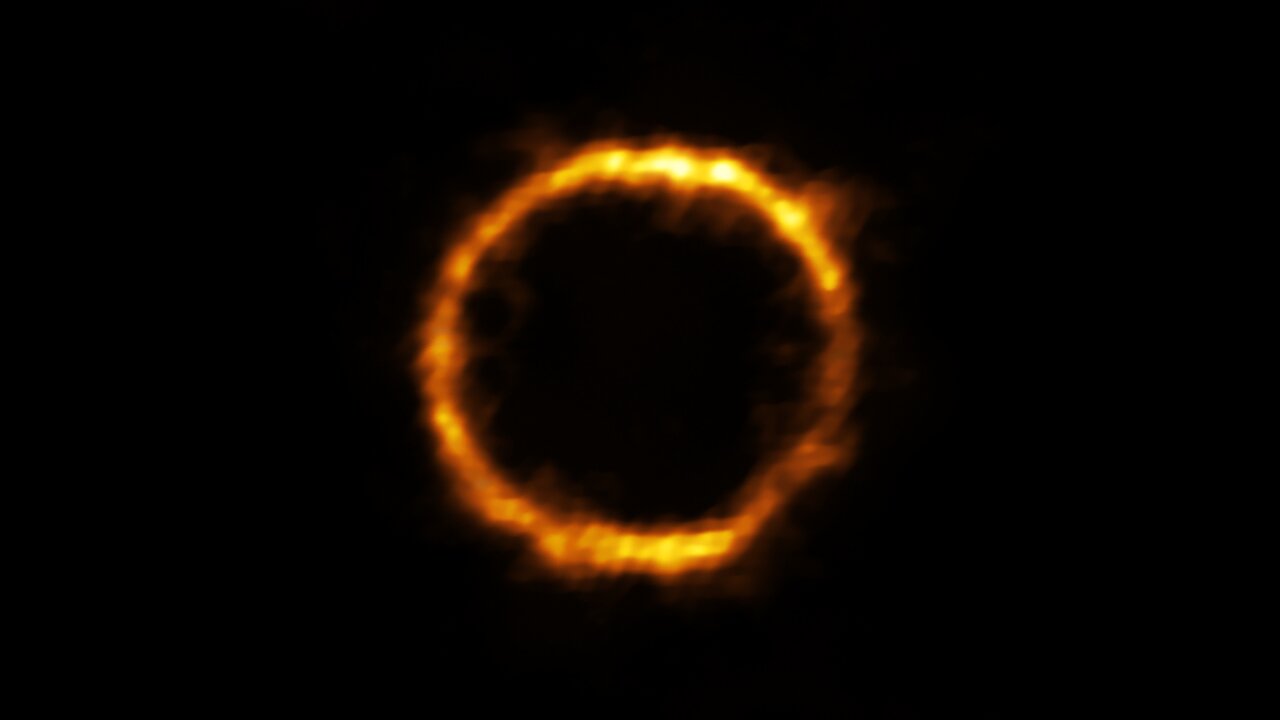

Astronomers using ALMA, in which the ESO is a partner, have revealed an extremely distant galaxy that looks surprisingly like our Milky Way. The galaxy, SPT0418-47, is gravitationally lensed by a nearby galaxy, appearing in the sky as a near-perfect ring of light.
The most widely accepted cosmological view states that the first galaxies formed about 380–400 million years after the Big Bang. These were made up of young, hot stars that lived fast and died young, causing the galaxies themselves to be turbulent. At least, that was the theory until a European team of astronomers observed a galaxy 12 billion light-years away that closely resembled the Milky Way.
Using the Atacama Large Millimeter-submillimeter Array (ALMA), the team observed the galaxy, SPT0418-47, as it appeared when the Universe was just 1.4 billion years old. Much to their surprise, the team noted that the structure and features of this galaxy were highly evolved and stable, something that contradicts previously-held notions about the nature of galaxies in the early Universe.
The study that describes the team’s findings, “A dynamically cold disk galaxy in the early Universe,” recently appeared in the journal Nature. The team was led by Francesca Rizzo, a Ph.D. student from the Max-Planck Institute for Astrophysics (MPIA), and included members from the Kapteyn Astronomical Institute, and the Netherlands Institute for Radio Astronomy (ASTRON).
Given its distance from Earth, the team was only able to observe SPT0418-47 with the help of the gravitational lensing technique. This technique relies on the gravitational force of a particularly massive structure (like a galaxy or galaxy cluster) that lies between the observer and the object being observed – which has the effect of amplifying the light coming from the more distant object.
Using a nearby galaxy as a lense that was almost exactly aligned, SPT0418-47 appeared as an almost perfectly-spherical ring of light around the nearer galaxy. The team then employed a new computer modeling technique to reconstruct the true shape of SPT0418-47’s and the motion of its gas. As Simona Vegetti, a gravitational lensing specialist from the MPIA and a co-author on the study, explained in an ESO press release:
“What we found was quite puzzling; despite forming stars at a high rate, and therefore being the site of highly energetic processes, SPT0418-47 is the most well-ordered galaxy disc ever observed in the early Universe. This result is quite unexpected and has important implications for how we think galaxies evolve.”
Another thing the team noted was how SPT0418-47 resembles the Milky Way. While it doesn’t appear to have spiral arms, it has two prominent Milky Way-like features: a rotating disk and a dense concentration of stars around the galactic center (a bulge). This is the first time a bulge has been seen in such an early galaxy, making SPT0418-47 the most distant Milky Way.
The presence of these features indicates that SPT0418-47 was highly stable, in spite of the fact that it was still very young when it was observed. At this juncture, during the early Universe, galaxies were still in the process of forming. Hence, astronomers expected that they would still be chaotic and lacking any of the distinct features that are typically observed in mature galaxies today. As Rizzo explained:
“This result represents a breakthrough in the field of galaxy formation, showing that the structures that we observe in nearby spiral galaxies and in our Milky Way were already in place 12 billion years ago.”
“The big surprise was to find that this galaxy is actually quite similar to nearby galaxies, contrary to all expectations from the models and previous, less detailed, observations,” added Filippo Fraternali, a professor of astronomy at the University of Groningen’s Kapteyn Astronomical Institute, located in the Netherlands.
However, Rizzo and her colleagues also note that while SPT0418-47 has a disc and other features that resemble those of mature spiral galaxies today, they expect this galaxy to have evolved into a galaxy that is much different from the Milky Way. In fact, they theorize that it is more likely that SPT0418-47 resembles an elliptical galaxy more closely than a spiral today.
While challenging, the study of galaxies like SPT0418-47 is fundamental to astronomers’ and cosmologists’ understanding of how galaxies formed and evolved. At a distance of 12 billion light-years, this galaxy (as it appears to observers on Earth) existed when the Universe was just 10% of its current age. In this respect, studying objects like SPT0418-47 allows astronomers to see what galaxies looked like when they just beginning to develop.
The discovery of prominent and stable features in SPT0418-47 therefore suggests that the early Universe may not have been as chaotic as previously thought. This comes shortly after a similar finding reported back in May, where a team of astronomers using ALMA discover a galaxy with a massive rotating disk (DLA0817g) that was comparably distant and existed 1.5 billion years after the Big Bang.
This raises many questions about how young galaxies could have become so well-ordered so soon after the Big Bang. Luckily, astronomers will have plenty of opportunities for further studies in the coming years thanks to next-generation observatories like the ESO’s Extremely Large Telescope and NASA’s James Webb and Roman Space Telescope.
These instruments will all be used to probe the earliest visible periods of the Universe, allowing astronomers to truly see how the first galaxies formed after the Big Bang, and how our Universe has evolved since.
The journey to Mars will subject astronauts to extended periods of exposure to radiation during…
Anthropogenic climate change is creating a vicious circle where rising temperatures are causing glaciers to…
Satellites often face a disappointing end: despite having fully working systems, they are often de-orbited…
Astronomers have known for some time that nearby supernovae have had a profound effect on…
How can we explore Saturn’s moon, Enceladus, to include its surface and subsurface ocean, with…
Have you ever wondered how astronomers manage to map out the Milky Way when it's…